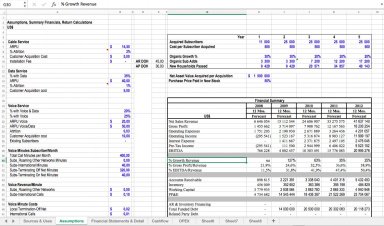
Publication number: ELQ-93159-1
View all versions & Certificate

Startup Excel Model
A startup financial model that can be sent to a Venture Capital, Private Equity Firm or Hedge Fund.
Prof. Robert H. Hacker offers you this Best Practice for free!
download for free
Add to bookmarks
Further information
A few things that would have changed the model design include:
1/ If I had a complex debt structure (combination of a line of credit, term loan and mezzanine debt) I would have used a separate tab for the "debt schedule" to make it easier to find
2/ If I had an operating company (instead of a startup) I would have included historical information for at least three years in the "financial summary" and probably have given it a separate tab; if you have a good operating history of revenue growth or a turnaround I would include five years of historical data
3/ If I had historical information on each acquisition, I would have forecasted/modeled each acquisition on a separate named tab (with a separate P&L and a balance sheet) and then consolidated them; such a presentation would have made it easier to understand the economics of each business unit and to evaluate the reasonableness of the purchase price
4/ If the headcount additions were based on time instead of capacity requirements (as shown in the model) I would have used date triggers to drive headcount additions
















